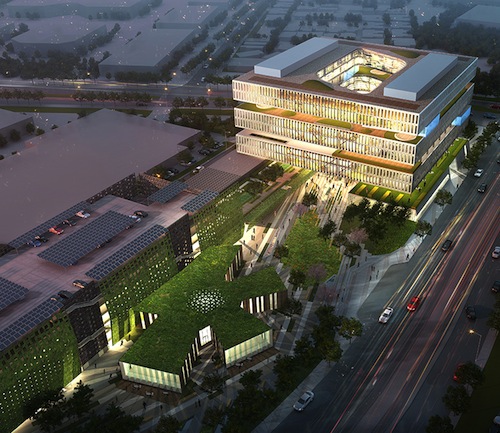Samsung Electronics will enter the Silicon Valley rivalry for best technology-oriented campus with its new headquarters design. The 1.1 million-sf San Jose campus, calculated to give Apple, Facebook and other local high-tech firms a run for their architectural money, will support at least 2,500 sales and R&D staff in Samsung's semiconductor and display businesses.
A pair of linked, 10-story office buildings, encompassing a combined 680,000 sf, will be the hallmark structure. Extensive "green floors" will be provided on every third story, creating a stack of alternating enclosed and open spaces. The gardens will be available to employees for informal breaks and organized recreation. Adjacent facilities will be connected by elevated walkways.
In addition to offices, the program includes research space, a cleanroom, a data center, basketball and sports courts, and cafés in a star-shaped amenities building. A parking structure for more than 1,500 vehicles will feature a rooftop solar array. NBBJ, also the architect behind the recently announced Google Bay View campus, is helming the project.
Samsung Information Systems America is getting new quarters as well. The company has signed a 15-year lease for two six-story buildings in Mountain View's Cypress Business Park, comprising about 385,000 sf.
The state of California is providing an R&D tax credit and an unspecified reimbursement for employee training. The city of San Jose is pitching in with a reduction of traffic impact fees (by more than 50%), a 75%+ reduction in construction taxes, a 50% rebate of up to half of utility taxes for 10 years, and a direct $500,000 economic incentive.
(http://articles.latimes.com/2013/feb/18/business/la-fi-samsung-silicon-valley-20130218)
Related Stories
| Aug 11, 2010
ZweigWhite names its fastest-growing architecture, engineering, and environmental firms
Management consulting and research firm ZweigWhite has identified the 200 fastest-growing architecture, engineering, and environmental consulting firms in the U.S. and Canada for its annual ranking, The Zweig Letter Hot Firm List. This annual list features the design and environmental firms that have outperformed the economy and competitors to become industry leaders.
| Aug 11, 2010
SSOE, Fluor among nation's largest industrial building design firms
A ranking of the Top 75 Industrial Design Firms based on Building Design+Construction's 2009 Giants 300 survey. For more Giants 300 rankings, visit http://www.BDCnetwork.com/Giants
| Aug 11, 2010
Guggenheim to host live online discussion of Frank Lloyd Wright exhibition
The Solomon R. Guggenheim Museum launches the Guggenheim Forum, a new series of moderated online discussions among experts from a variety of fields that will occur in conjunction with major museum exhibitions.
| Aug 11, 2010
Best AEC Firms of 2011/12
Later this year, we will launch Best AEC Firms 2012. We’re looking for firms that create truly positive workplaces for their AEC professionals and support staff. Keep an eye on this page for entry information. +
| Aug 11, 2010
Report: Building codes and regulations impede progress toward uber-green buildings
The enthusiasm for super green Living Buildings continues unabated, but a key stumbling block to the growth of this highest level of green building performance is an existing set of codes and regulations. A new report by the Cascadia Region Green Building Council entitled "Code, Regulatory and Systemic Barriers Affecting Living Building Projects" presents a case for fundamental reassessment of building codes.
| Aug 11, 2010
Call for entries: Building enclosure design awards
The Boston Society of Architects and the Boston chapter of the Building Enclosure Council (BEC-Boston) have announced a High Performance Building award that will assess building enclosure innovation through the demonstrated design, construction, and operation of the building enclosure.
| Aug 11, 2010
Portland Cement Association offers blast resistant design guide for reinforced concrete structures
Developed for designers and engineers, "Blast Resistant Design Guide for Reinforced Concrete Structures" provides a practical treatment of the design of cast-in-place reinforced concrete structures to resist the effects of blast loads. It explains the principles of blast-resistant design, and how to determine the kind and degree of resistance a structure needs as well as how to specify the required materials and details.







